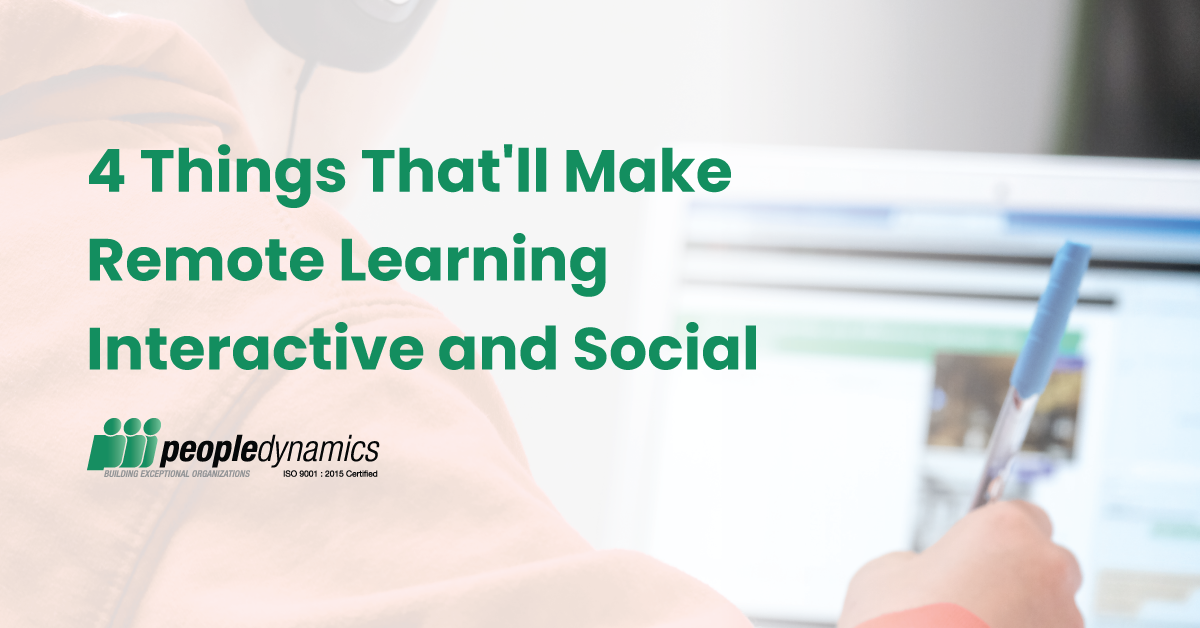Humans are social beings. As a human, social interactions are essential for you to survive. The same rule applies when acquiring knowledge.
The 70-20-10 model for learning and development explains that 20% of learning comes from your interaction with others—a challenge for remote education. Since the learner and instructor are separated by time and distance, especially when remote learning is asynchronous, there’s little interaction. Your learners can’t get a good chunk of necessary knowledge and information. But, fear not—you can make your remote learning interactive and social!
Here are four things you can do.
4 Things That’ll Make Remote Learning Interactive and Social
Use a collaborative platform
To make your remote learning interactive, you first need a platform to help you.
Use video conferencing tools for synchronous sessions for the participants and facilitator to have real-time engagement.
You can also use a learning management system with built-in collaboration tools like forums or virtual classrooms.
When deciding on a platform, carefully evaluate how it’ll help you meet your objectives. You also have to consider your capability to purchase it and if you’ll be able to maximize its value. Remember to weigh the pros and cons and decide which best suits your learning programs.
Encourage discussions and question and answer
What’s one of the best ways to make your participants interact? Discussions.
When conducting a remote learning program, encourage discussions among your learners. It could be during the session or through post-event platforms like forums. You can also initiate dialogue about the program contents through question and answer.
Participants will learn better if they express their understanding of the course topic and inquire about the parts they have doubts about or can’t understand.
Here are other things you could do to promote discussion:
- Separate learners into smaller groups to do their deliberations, preferably in a breakout room so they could talk freely.
- Do interactive exercises such as role-plays and simulations, which work online but only need more preparation.
- Ask your participants’ opinions on thought-provoking statements or situations.
Gamify your remote learning to make it interactive
Gamification has been a controversial topic in learning and development. Some swear that it made their training programs better and more engaging, while some claim it’s only a fad. But, the concept behind gamification, which is the use of game mechanics to drive engagement in non-game business scenarios and to change behaviors in a target audience to achieve your goals, is indeed beneficial to learning and development.
As a human, you have this innate desire to be better than others. It’s common to compare yourself. You feel good if you win and feel bad if you lose. There’s nothing wrong with that. And games are good at invoking this sense of competition within you. When you gamify your remote learning, you make your learners more excited and active in the course. Which, in turn, makes them more participative, more social—more engaged. A little healthy competition in your remote learning goes a long way.
You can even take a step further to nurture this motivation by offering rewards or incentives. After all, positive reinforcement is critical. Having a reward for a job well done makes them want to do better so that they could have the same or an even better prize for their work.
Here are some ideas to gamify your remote learning:
- add fun quizzes or tests,
- integrate games in your programs, and
- score your learners when they answer your questions correctly and reward them if they get the highest points.
Ask for feedback
Getting feedback is an opportunity for inspiring exchange. At the same time, you can also learn how well your remote learning program did from the participants’ perspective and even get insights on things to improve.
You can start with questions like “How did you feel about today’s [course topic/learning program]?”, “What thing/s stuck to your mind in this course?” or “What did you learn today?”.
You could also use a post-attendance survey to have a more streamlined process for gathering feedback. Make sure to ask for comments on what they liked, didn’t like, and could’ve been done better, and learn from those for your future remote learning programs.
Just because remote learning has the word “remote” in it doesn’t mean that your participants have to feel isolated during it. Use the four things we listed above to make your remote learning more interactive and social!
We present LearnED, a learning management system (LMS) powered by People Dynamics, Inc., an alternative learning system just for you! LearnED has collaborative and interactive features such as virtual classrooms, discussion boards, and more! People Dynamics, Inc. also provides learning and development services such as in-house remote learning programs for your organization. For more information, please email us at lms@peopledynamics.coor contact us through this link: https://learnedlms.com/contact-us/.




